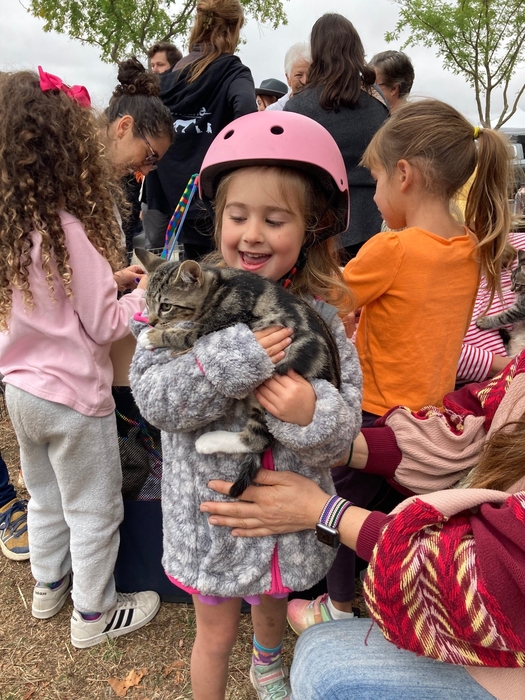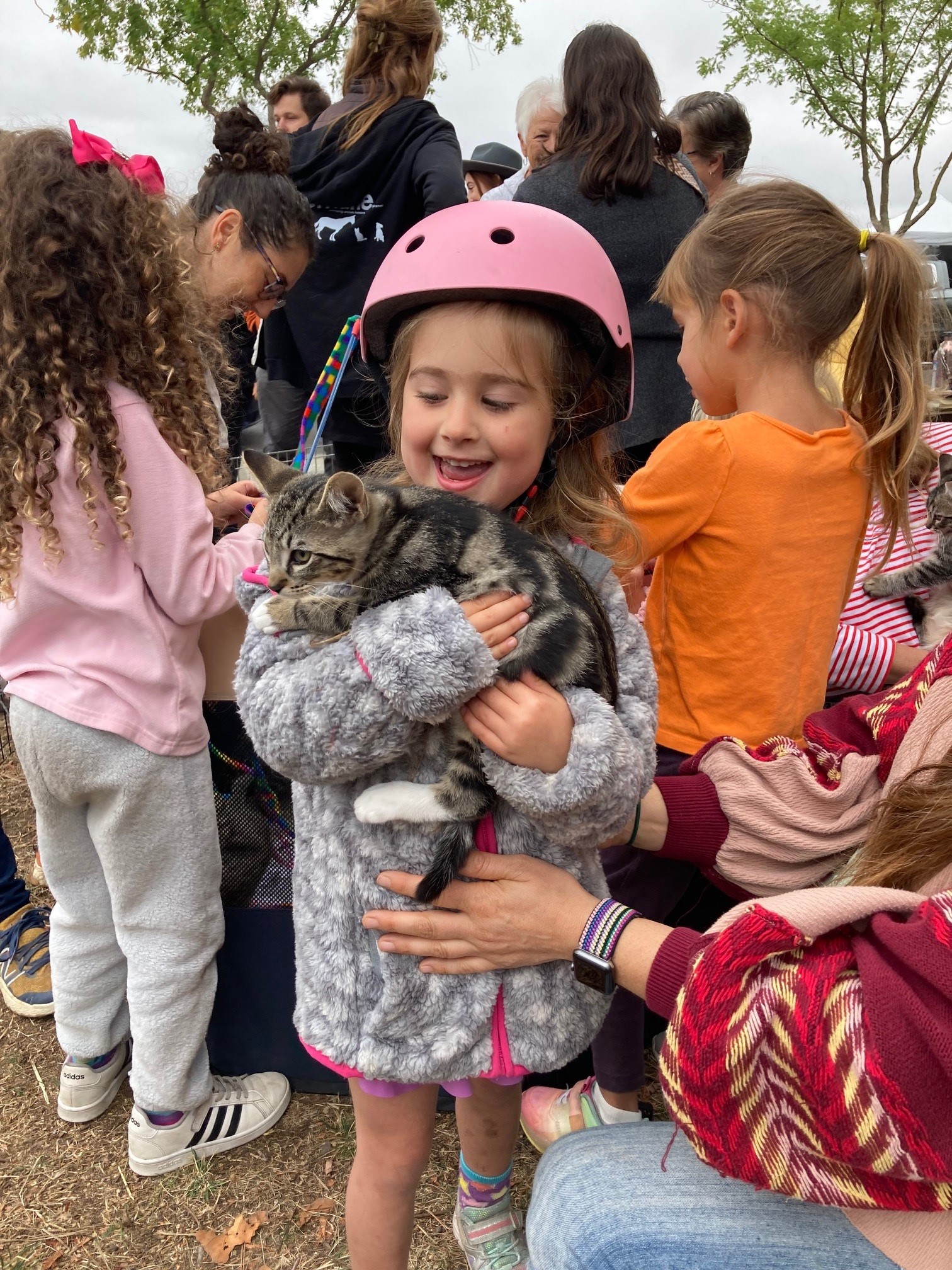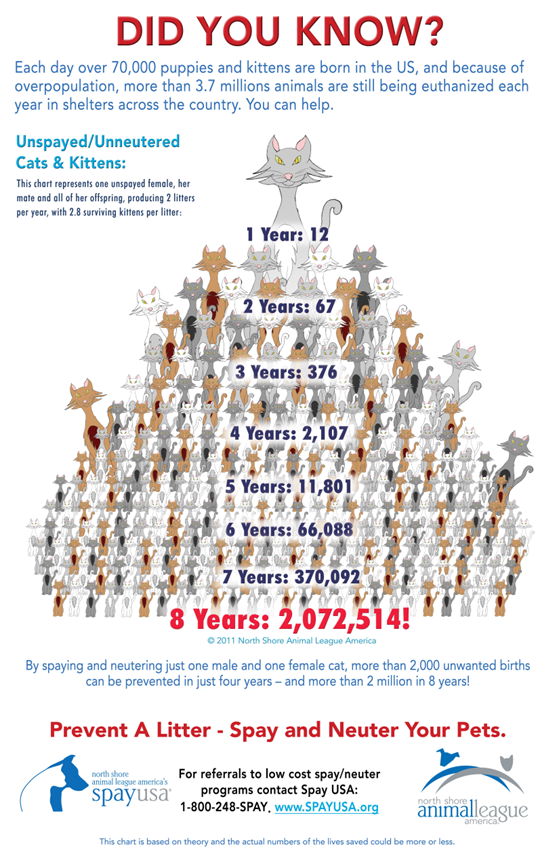Blog


It's Kitten Season! The Critical Importance of Spay & Neuter
By Jeffrey Richard, Jameson Humane Volunteer
With the approach of Spring, we are again in the throes of “kitten season” among both feral cats and domesticated pets. Melissa Bush, Companion Animal Program Manager for Jameson Humane, describes this yearly event,
“Kitten season typically occurs from early spring to late fall, but cats can't be bothered with seasonal restrictions. Female cats can give birth multiple times a year, year-round, having an average of 4-8 kittens per litter. If we didn't spay and neuter our resident and community cats, we could have a kitten explosion on our hands which is exactly what we saw through the pandemic when many low-cost and no-cost spay/neuter options were unavailable. Quite the CATastrophe! Spaying and neutering your pets not only helps to keep them healthy but it also helps to prevent overpopulation. It's also important to look after our community or "feral" cats which can be done through "Trap, Neuter, Return" (TNR) programs or TNR focused rescue groups in your area. Preventing over-population is possible and spay/neuter is the first step in the right direction."
As a result, it is time once more to discuss the critical need for spaying and neutering of pets and feral cats. In Jameson Humane’s February 2022 Blog article, A Sensible, Humane Solution to the Over-Population of Community Cats – Trap, Neuter and Return, we described the benefits of Trap/Neuter/Return (TNR) programs as the only humane and realistic way to control and, one would hope, ultimately reduce the population of feral “community” cats. This article expands on that earlier coverage of the spay/neuter topic.
Spaying and Neutering Pets Benefits Both Them and Society
“Spaying” a cat or dog is the removal of a female’s ovaries, while “neutering” is the removal of a male’s testes. Both are relatively routine surgeries performed by a veterinarian while the animal is under anesthesia. Spayed females will no longer go into heat, become pregnant, or endure the discomfort and health risks of birthing and the drain on energy and physical demands of nursing and caring for kittens or puppies. Neutered males will no longer be able, or have the urge, to impregnate a female, will become more docile, and will be less prone to fight with other males. Studies have also shown that early spaying and neutering of cats and dogs will make them less susceptible to certain reproductive ills and diseases including cancer.
Spaying and neutering pets and community cats also benefits society in general by avoiding an additional huge burden on animal shelters and rescue organizations of unwanted or abandoned pets. Overcrowding at shelters also increases the number of animals that are euthanized when no one adopts them. The relatively simple step of spaying and neutering pets will avoid that awful consequence suffered by unwanted animals.
The Napa Humane website details the benefits of spaying and neutering cats and dogs:
In every community, in every state, there are homeless animals. In the U.S., there are an estimated 6-8 million homeless animals entering animal shelters every year. The single most important thing that we can do to save cats and dogs from all the suffering and death that their overpopulation causes is to spay and neuter them. Spaying and neutering reduces or eliminates:
- The odds of breast cancer and dangerous uterine infections in females and prostate problems and testicular cancer in males.
- Frustration in resisting the natural urge to mate. Your companion will be less distracted, more easily trained, and a more contented member of your family.
- The animal’s need to roam in search of a mate, decreasing the chances that your pet will become lost, get into fights with other animals or be hit by a car.
- Messy heat cycles in females and attracting unwanted males.
- The tendency to bite. However, your pet will still be protective of his home and family even after being altered. Aggression is different from protectiveness.
- Spraying, wailing, marking territory, or making inappropriate sexual approaches toward people or objects.
(Source: https://napahumane.org/our-work/spayneuter-vaccinations-microchipping/why-spay-or-neuter/ .)
Unless Trap/Neuter Release Programs Are Expanded, It is Likely that the Community Cat Population Will Continue to Increase Exponentially
Although there is no way to know exactly how fast the community cat population is growing, there is no doubt that it is out of control and the unrestrained population growth is causing much suffering among community cats and especially kittens who fall victim to the 75 to 80 percent mortality rate that affects young ferals.
A number of animal support organizations have published alarming projections and graphic depictions of what reproduction by a single community cat can lead to in terms of population growth. An example is a poster pasted below published by the North Shore Animal League America, which suggests that in 12 years, a single unspayed female and her progeny will produce more than 2 million cats. (It should be noted that this projection is likely too aggressive because it fails to account for the sad fact of the very high mortality rate of kittens who never reach the age of mating. Even the poster itself notes: “This chart is based on theory and the actual numbers of the lives saved [by spaying and neutering feral cats] could be more or less.”) But the truth is that the community cat population is increasing exponentially, with devastating consequences not only for the community kittens who suffer and die of starvation and illness, but for the ecology and wildlife in their territories. Dr. Fielding O’Niel, DMV, of the Tuckahoe Veterinary Hospital, analyses the mushrooming community cat population, the resulting negative impacts on wildlife, and TNR as a possible solution:
Current scientific data is sketchy, but most estimates place the number of wild or feral cats in America at 70 million and rising. This includes cats that were abandoned, lost and those born in the wild.
Females in this population have an average of 1.6 litters each year with an average of 5 kittens per litter. Males are responsible for an average of 7 pregnancies per year. Eighty percent of kittens born in the wild will die before 1 year of age from the same causes that afflict all wild life - starvation, disease and trauma. This magnitude of suffering is incomprehensible.
These cats are highly adaptive natural predators and survive at the expense of wildlife. Research estimates that each feral cat kills 7 birds a year. That is 500 million birds killed annually nationwide, many on the endangered species list. Birds are third on the menu behind reptiles and small mammals (mice, rabbits, chipmunks and squirrels). It is estimated that feral cats, trying to survive, destroy 2 billion birds, mammals and reptiles each year in America.
The obvious solution to this problem is population control. All pets must be neutered and, in many areas, this is mandated by law. Controlling feral populations is more difficult. One program gaining favor is Trap, Neuter and Release (TNR). While this doesn't reduce existing populations, it does limit those of the future.
(Source: https://www.tuckahoevet.com/post/feral-cats-in-america#:~:text)

The Pandemic Has Drastically Reduced the Number of Community Cats and Pets Being Spayed and Neutered
The San Jose Mercury-News published an article on November 28, 2021 about the feral cat crisis and the lack of spay/neuter services, which is excerpted here:
Stray and feral cats and the volunteer groups that try to help them are in the eye of a perfect storm, caught in the vortex of too few veterinarians and too little staff, COVID challenges and changes in the ways public shelters operate.
. . . At the crux of the storm is a lack of veterinarians and trained staff to perform necessary spay/neuter surgeries on so-called community cats. Groups that once offered free or low-cost operations closed their doors during the pandemic or drastically cut back on the number of procedures they can safely perform.
This isn’t just a localized problem, either, although each area has its unique challenges. Every rescue group in the Bay Area that does TNR — trap, neuter, return — is having problems finding appointments to have the cats neutered.
. . . The staffing problem is widespread. Some 87 percent of U.S. shelters are understaffed, according to an August survey by the Best Friends Animal Society. . . .
. . . TNR groups worry that without adequate neutering efforts, the feral cat population, estimated at 70 million across the U.S., will continue to grow. . . .
Unfortunately, as of late 2022, the impact of the pandemic and the ongoing shortage of veterinarians across the country had not improved. According to an article published by the University of Florida in September 2022:
New research finds that there are almost 3 million missing neuter/spay surgeries in the U.S. due to the pandemic, which, combined with veterinarian and staff shortages, is contributing to widespread overcrowding at pet shelters.
. . . All the impacts of the pandemic combined have the potential to undermine progress made in controlling pet populations and euthanasia in shelters . . . Currently, shelters are in crisis mode, with overcrowding and lagging adoptions . . . Pet overpopulation seems to be increasing, leading to increased shelter euthanasia for the first time in many years.
Jameson Humane’s Role
In next month’s article, we will discuss the great support being provided by Jameson Humane’s Mobile Vet Unit to pets and their owners. And as we described last February, Jameson is helping to carry out the community’s responsibility to care for community cats. When alerted to the presence of community cats, Jameson staff observes the cats and provides essential support, including nourishment and medical care when needed. Jameson staff evaluates the overall appearance and behavior of each cat: Does it have clear eyes? Is its coat clean? Does it seem to be in good health? If so, then the cat is likely thriving in its colony. If not, it might be lost or abandoned and living on its own as a stray. Jameson Humane staff tries to determine whether the cat should remain in the wild or whether it is a candidate for potential socialization and adoption.
Jameson will check each cat to determine whether it has been spayed or neutered. Initially, they check the cat’s ears. If one of the ears is clipped or “tipped,” this indicates that the cat has been spayed or neutered and is likely living in a cat colony. If a cat does not have a tipped ear, no sign of a tag, and seems timid around people, it should be trapped to determine the whether it needs to be spayed or neutered.
Spay/Neuter Guidance and Resources
Those in the community who see feral or abandoned cats and are interested in initiating the TNR process can use those same indicators described above to determine whether the cat has already been spayed or neutered.
Alley Cat Allies (ACA) has published detailed instructions and advice for those who find community cats and want to pursue TNR. They summarize their ideal view of the basic steps as follows:
- Trap: Humanely trap all the cats in a colony. A colony is a group of cats living outdoors together.
- Neuter (or spay): Take the cats in their traps to a veterinarian or clinic to be neutered, vaccinated, and eartipped (the universal symbol of a neutered and vaccinated cat. Learn more at alleycat.org/Eartip).
- Return: After the cats recover, return them to their outdoor home where they were trapped.
Watch videos of cats being returned and how to do Trap-Neuter-Return at youtube.com/AlleyCatAllies.
(Source: https://www.alleycat.org/resources/how-to-help-community-cats-a-step-by-step-guide-to-trap-neuter-return/ .)
Alley Cat Allies has also created a spay-neuter resource that it calls the “Feral Friends Network.” The Network includes veterinarians with community cat experience and others who provide low-cost spay and neuter services. Use the following link for a form to use to request a list of Network members in your area: https://www.alleycat.org/our-work/feral-friends-network/feral-friends-network-connect/
From a local perspective, as we described last February, the County of Napa through its Animal Shelter offers rental of traps to members of the public for TNR purposes and provides vouchers for presentation to the clinic to defray the cost of spaying and neutering. The Animal Shelter’s rental of traps is free of charge except for a $50 deposit that is refunded if the traps are brought back in good condition and in a timely manner. And the County’s voucher program to defray the cost of spaying or neutering any animal is described on the website as follows:
Spaying and neutering is the best defense against unwanted litters, which then prevents additional animals from entering the shelter system. Spaying and neutering can also eliminate mating related nuisance behaviors such as roaming, vocalizing and even aggression. Medical conditions such as pyometra (infection of the uterus) and many reproductive cancers are non-existent when animals are sterilized. However, due to the rising costs of veterinary care, finding affordable spay/neuter for your pet can be challenging. Thankfully, the Napa County Animal Shelter and Adoption Center offers spay/neuter vouchers for Napa County residents. The vouchers cover the cost of any dog, cat, rabbit and feral cat spay/neuter done at the Napa Humane Spay/Neuter Clinic (707-252-7442) located at 3265 California Blvd. in Napa, 94558.
(Source: https://www.countyofnapa.org/3163/SpayNeuter-Voucher-Program )
